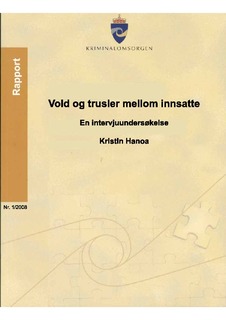| dc.description.abstract | This study takes an explorative and qualitative approach. In a Norwegian context
there exists little systemised knowledge regarding violence and threats among
inmates. An appropriate approach was
therefore to interview inmates and let them provide an insight into their
experiences and perceptions of why and how threats occur. Through the report the
informants have painted a complex picture of what the threats entail, and which
underlying causes they feel are most important.
The events are largely linked to the prison conditions the informants live under,
where different burdens of prison life are highlighted as important explanations.
These include living in close quarters with other inmates, numerous lockups and
pent-up frustrations, or situations where the informants feel overlooked or treated
in a manner they feel is demeaning. These are described as frustrating aspects of
an everyday prison life that is otherwise characterised by routines, rules and very
little opportunity to influence one’s surroundings, something that leads to
increased levels of conflict between the inmates as well as an increased risk of
threats and violence. Power structures within the prison population are also
emphasised as important parts of the cause for threats and violence. The
informants describe a culture between inmates where it is important to make your
mark and stand out, and they provide examples of situations where they feel it is
of particular importance to position oneself in order to ensure one’s own position
or to avoid being subjected to violence or demeaning treatment.
Some stigmatised groups are singled out as being particularly at risk for threats
and violence: snitches, sexual offenders or inmates that in different ways
differentiate themselves from the others. The reason why these groups are more at
risk than others seem to be connected to several factors, but as a whole it can be
seen as a result of an inmate culture where certain groups being stigmatised
constitute a lower threshold for subjecting them to bullying, threats and violence.
Other causes for conflict, threats and violence are less obvious, but still of great
importance for the informants they apply to. These include language problems,
ethnicity or the informants’ perception of what constitutes good behaviour and
mutual respect. Drugs, gang-related problems and gambling were also relevant
causes, but for different reasons they made up a smaller part of the material than
anticipated. | en_US |
